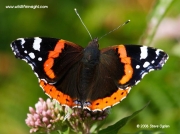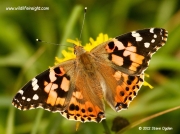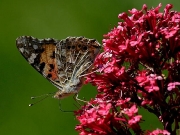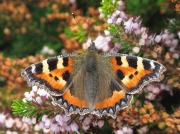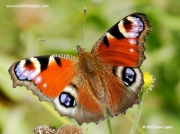Introduction to British Vanessid Butterflies
The Vanessid butterflies of the Nymphalidae sub family Nymphalinae are shown in the galleries below together with links to species pages.
The large Nymphalidae family includes the Vanessids, Fritillaries and Browns. There is much ongoing debate amongst taxonomists as to whether nymphalids should be considered one inclusive group or split into several separate families.
In Europe the large Nymphalidae family is well represented.
The Vanessid species found in the British Isles include some of the most commonly seen butterflies. Two of the species, The Red Admiral and Painted Lady are mainly migrant species and unable to survive the cold winters. Although in recent mild winters Red Admiral butterflies and the caterpillars have been successfully overwintering in the mildest parts of England.
The Camberwell Beauty and the once resident Large Tortoiseshell are two species recorded as migrants to the UK in small numbers but haven’t been recorded breeding in recent times.
Butterflies from two of the other Nymphalidae sub families, Admirals Limenitidinae and Emperors Apaturinae are also featured.
Red Admiral (Vanessa atalanta)
The Red Admiral Butterfly species page has images and descriptions of the butterfly and its life cycle including caterpillar and pupa.
Painted Lady (Vanessa cardui)
The Painted Lady Butterfly species page has images and descriptions of the butterfly and its life cycle including caterpillar and pupa.
Small Tortoiseshell (Aglais urticae)
The Small Tortoiseshell Butterfly species page has images and descriptions of the butterfly and its life cycle including caterpillar and pupa.
Large Tortoiseshell Butterfly (Nymphalis polychloros)
The Large Tortoiseshell butterfly was once resident and widespread in the southern half of England and Wales. Sadly, today, it is no longer considered to be resident. Recent records are considered to be either of captive bred releases or migrants from continental Europe. The increase in numbers in recent years in southern regions suggest the butterfly may recolonise in the near future.
The Large Tortoiseshell featured was recorded by Paul Browning in Granada, Spain.
Peacock (Inachis io)
The Peacock Butterfly species page has images and descriptions of the butterfly and its life cycle including caterpillar and pupa.
Comma (Polygonia c-album)
The Comma Butterfly species page has images and descriptions of the butterfly and its life cycle including caterpillar and pupa.
White Admiral (Limentis camilla)
This butterfly is from the sub family Limenitidinae.
Awaiting images.
Purple Emperor (Apatura iris)
This butterfly is from the sub family Apaturinae.
The Purple Emperor is one of the British Isles most spectacular butterflies. Sadly numbers have been in decline for many years and has disappeared from much of its former range. The largest populations are now found in mature deciduous woodland of southern England.
On the continent it is still found in much of Europe but absent from the warmest, southern Mediterranean regions.
The specimen featured was recorded in Spain by Paul Browning. More images of the Purple Emperor and the Lesser Purple Emperor are featured in the European butterfly galleries.
Camberwell Beauty (Nymphalis antiopa)
The magnificent Camberwell Beauty butterfly is a scarce migrant to the UK from Scandinavia and mainland Europe. Hopes are high that it may soon breed in eastern England in the near future where it is most commonly recorded.
In North America the Camberwell Beauty is known as the Mourning Cloak
The specimen featured was recorded in Lleida, Spain by Paul Browning.
Links to Other British Butterfly Galleries:
- British Skipper butterflies (Hesperiidae)
- British Swallowtail butterflies (Papilionidae)
- British White and yellow butterflies (Pieridae)
- British Hairstreak butterflies (Theclinae)
- British Copper butterflies (Lycaeninae)
- British Blue butterflies (Polyommatinae) and Metalmark butterflies (Riodinidae)
- British Vanessid butterflies (Nymphalinae) and Admiral butterflies (Limenitidinae) and Emperor butterflies (Apaturinae) – this page
- British Fritillary butterflies (Heliconiinae)
- British Brown butterflies (Satyrinae)
